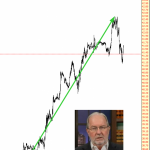Here’s the difference between a recession and a depression: you can’t get blood from a stone, or make an insolvent entity solvent with more debt.
There are two basic differences between a recession and a depression:
Recessions are brief because the basic dynamic is to write down defaults, tighten up credit and absorb the losses from failed speculations. As consumers and enterprises cut back borrowing, they trim spending, leading to layoffs, reduced tax revenues, contraction of credit and all the other consequences of wringing excesses out of the economy.
But once the losses have been absorbed and insolvent households and enterprises have worked through bankruptcy, then the decks are cleared for a renewed credit/business cycle expansion.
Depressions, on the other hand, are generated by self-reinforcing feedback loops: insolvencies beget more insolvencies, reduced prices for assets beget lower prices for assets, and so on.
There are two critical differences between the two dynamics: high fixed costs and dependence on credit/asset bubbles for “growth.” Recessions clear excesses in otherwise healthy economies with low fixed costs, rising productivity, broadly distributed gains in earned income, safe yields on capital set aside for savings and retirement and high returns on productive investments. Growth is the result of rising productivity of labor and capital.







Leave A Comment